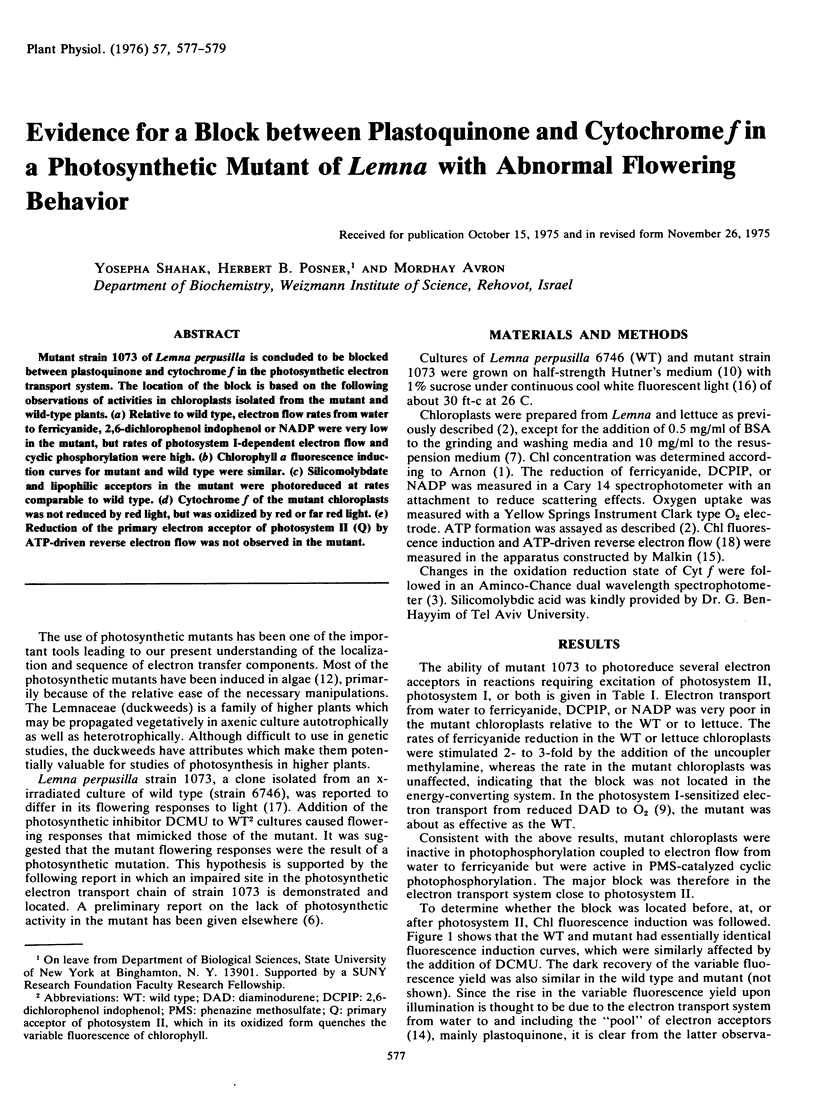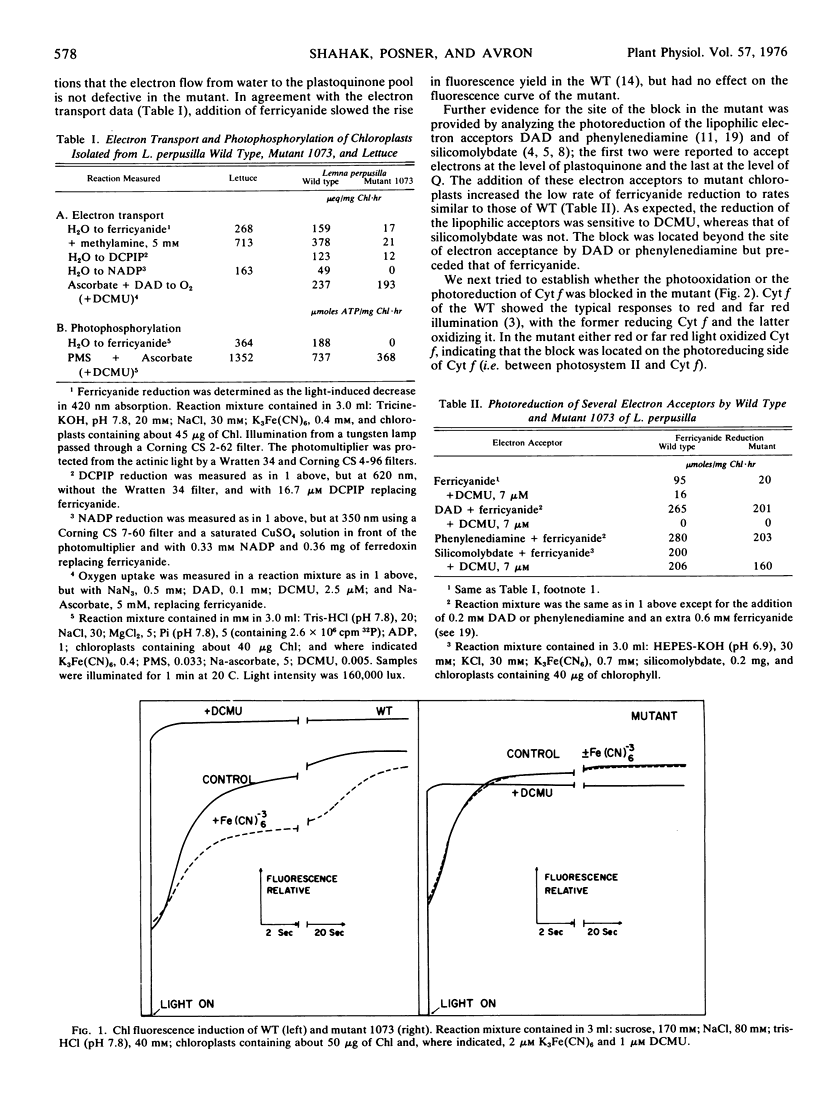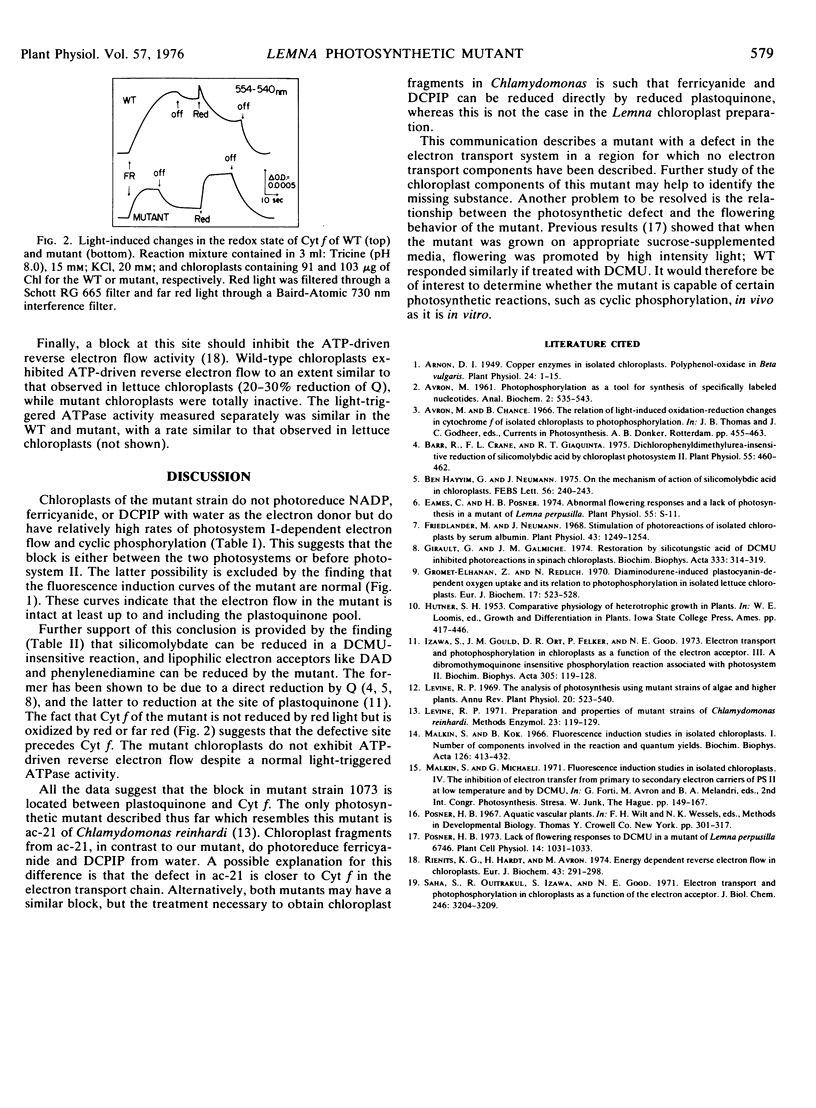Abstract
Mutant strain 1073 of Lemna perpusilla is concluded to be blocked between plastoquinone and cytochrome f in the photosynthetic electron transport system. The location of the block is based on the following observations of activities in chloroplasts isolated from the mutant and wild-type plants. (a) Relative to wild type, electron flow rates from water to ferricyanide, 2,6-dichlorophenol indophenol or NADP were very low in the mutant, but rates of photosystem I-dependent electron flow and cyclic phosphorylation were high. (b) Chlorophyll a fluorescence induction curves for mutant and wild type were similar. (c) Silicomolybdate and lipophilic acceptors in the mutant were photoreduced at rates comparable to wild type. (d) Cytochrome f of the mutant chloroplasts was not reduced by red light, but was oxidized by red or far red light. (e) Reduction of the primary electron acceptor of photosystem II (Q) by ATP-driven reverse electron flow was not observed in the mutant.
Full text
PDF


Selected References
These references are in PubMed. This may not be the complete list of references from this article.
- AVRON M. Photophosphorylation as a tool for the synthesis of specifically labeled nucleotides. Anal Biochem. 1961 Dec;2:535–543. doi: 10.1016/0003-2697(61)90021-5. [DOI] [PubMed] [Google Scholar]
- Arnon D. I. COPPER ENZYMES IN ISOLATED CHLOROPLASTS. POLYPHENOLOXIDASE IN BETA VULGARIS. Plant Physiol. 1949 Jan;24(1):1–15. doi: 10.1104/pp.24.1.1. [DOI] [PMC free article] [PubMed] [Google Scholar]
- Barr R., Crane F. L., Giaquinta R. T. Dichlorophenylurea-insensitive Reduction of Silicomolybdic Acid by Chloroplast Photosystem II. Plant Physiol. 1975 Mar;55(3):460–462. doi: 10.1104/pp.55.3.460. [DOI] [PMC free article] [PubMed] [Google Scholar]
- Ben-Hayyim G., Neumann J. On the mechanism of action of silicomolybdic acid in chloroplasts. FEBS Lett. 1975 Aug 15;56(2):240–243. doi: 10.1016/0014-5793(75)81100-8. [DOI] [PubMed] [Google Scholar]
- Friedlander M., Neumann J. Stimulation of photoreactions of isolated chloroplasts by serum albumin. Plant Physiol. 1968 Aug;43(8):1249–1254. doi: 10.1104/pp.43.8.1249. [DOI] [PMC free article] [PubMed] [Google Scholar]
- Gromet-Elhanan Z., Redlich N. Diaminodurene-induced plastocyanin dependent oxygen uptake and its relation to photophosphorylation in isolated lettuce chloroplasts. A comparison of the systems using either water or ascorbate as the electron donors. Eur J Biochem. 1970 Dec;17(3):523–528. doi: 10.1111/j.1432-1033.1970.tb01195.x. [DOI] [PubMed] [Google Scholar]
- Izawa S., Gould J. M., Ort D. R., Felker P., Good N. E. Electron transport and photophosphorylation in chloroplasts as a function of the electron acceptor. 3. A dibromothymoquinone-insensitive phosphorylation reaction associated with photosystem II. Biochim Biophys Acta. 1973 Apr 27;305(1):119–128. doi: 10.1016/0005-2728(73)90237-5. [DOI] [PubMed] [Google Scholar]
- Malkin S., Kok B. Fluorescence induction studies in isolated chloroplasts. I. Number of components involved in the reaction and quantum yields. Biochim Biophys Acta. 1966 Nov 8;126(3):413–432. doi: 10.1016/0926-6585(66)90001-x. [DOI] [PubMed] [Google Scholar]
- Rienits K. G., Hardt H., Avron M. Energy-dependent reverse electron flow in chloroplasts. Eur J Biochem. 1974 Apr 1;43(2):291–298. doi: 10.1111/j.1432-1033.1974.tb03412.x. [DOI] [PubMed] [Google Scholar]
- Saha S., Ouitrakul R., Izawa S., Good N. E. Electron transport and photophosphorylation in chloroplasts as a function of the electron acceptor. J Biol Chem. 1971 May 25;246(10):3204–3209. [PubMed] [Google Scholar]


